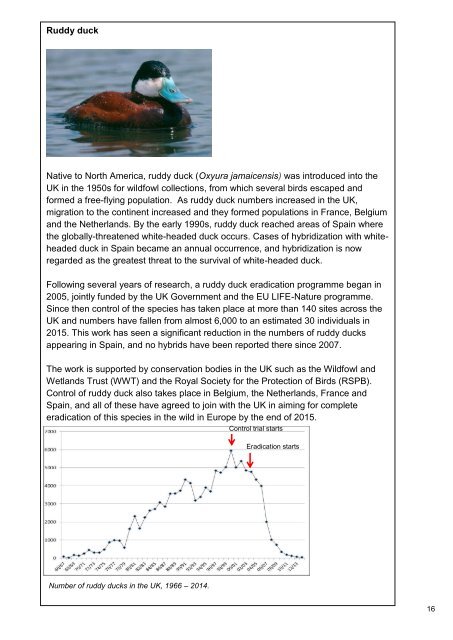The Great Britain Invasive Non-native Species Strategy
gb-non-native-species-strategy-pb14324
gb-non-native-species-strategy-pb14324
You also want an ePaper? Increase the reach of your titles
YUMPU automatically turns print PDFs into web optimized ePapers that Google loves.
Ruddy duckNative to North America, ruddy duck (Oxyura jamaicensis) was introduced into theUK in the 1950s for wildfowl collections, from which several birds escaped andformed a free-flying population. As ruddy duck numbers increased in the UK,migration to the continent increased and they formed populations in France, Belgiumand the Netherlands. By the early 1990s, ruddy duck reached areas of Spain wherethe globally-threatened white-headed duck occurs. Cases of hybridization with whiteheadedduck in Spain became an annual occurrence, and hybridization is nowregarded as the greatest threat to the survival of white-headed duck.Following several years of research, a ruddy duck eradication programme began in2005, jointly funded by the UK Government and the EU LIFE-Nature programme.Since then control of the species has taken place at more than 140 sites across theUK and numbers have fallen from almost 6,000 to an estimated 30 individuals in2015. This work has seen a significant reduction in the numbers of ruddy ducksappearing in Spain, and no hybrids have been reported there since 2007.<strong>The</strong> work is supported by conservation bodies in the UK such as the Wildfowl andWetlands Trust (WWT) and the Royal Society for the Protection of Birds (RSPB).Control of ruddy duck also takes place in Belgium, the Netherlands, France andSpain, and all of these have agreed to join with the UK in aiming for completeeradication of this species in the wild in Europe by the end of 2015.Control trial startsEradication startsNumber of ruddy ducks in the UK, 1966 – 2014.16


